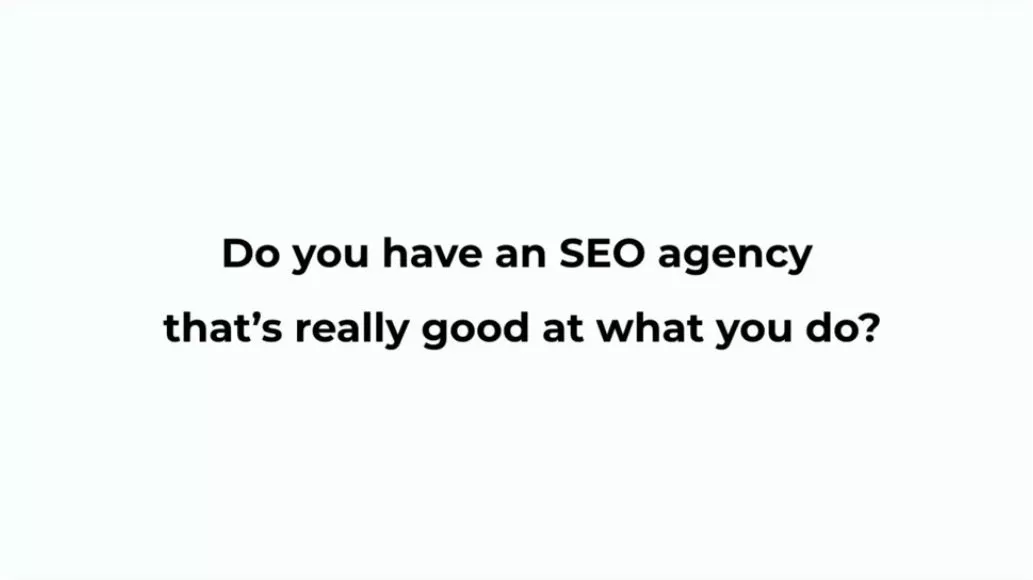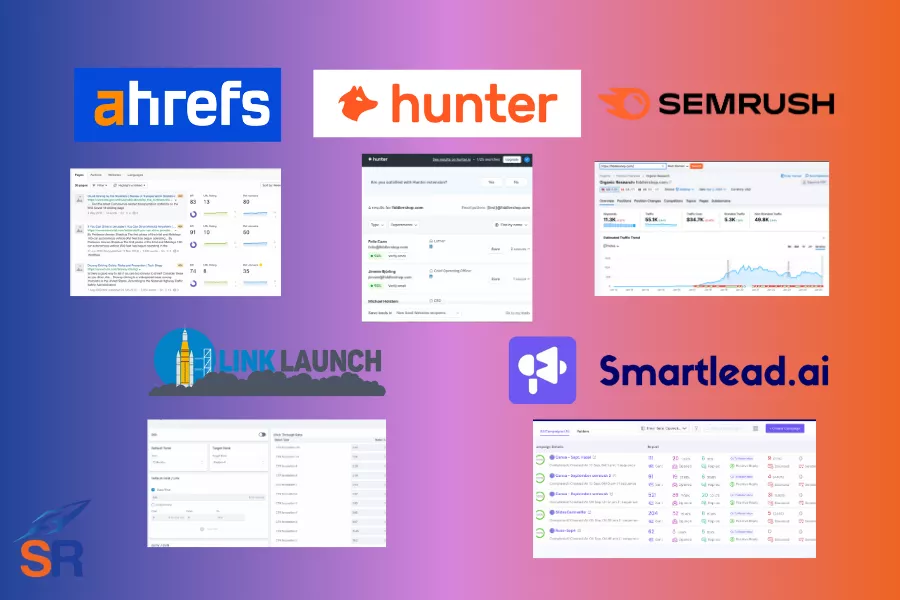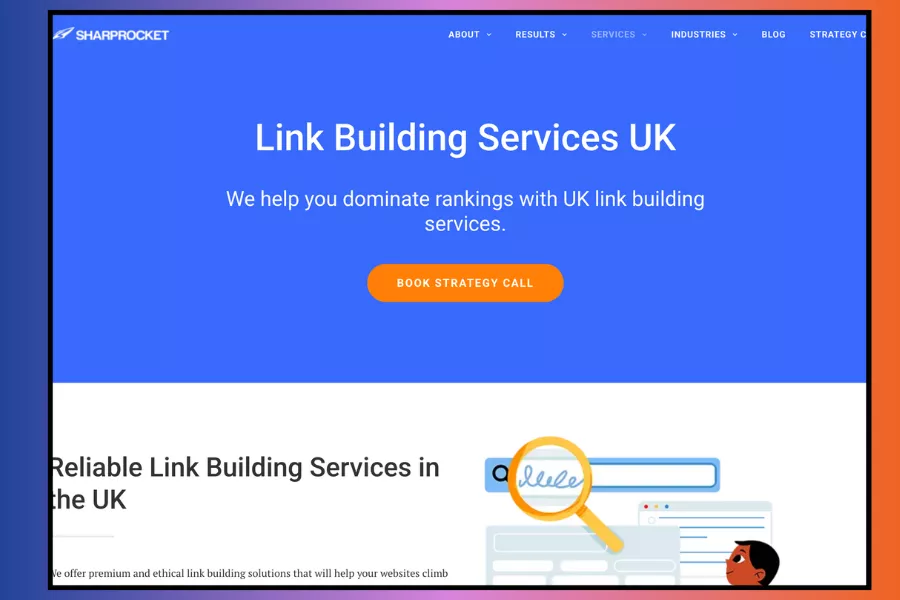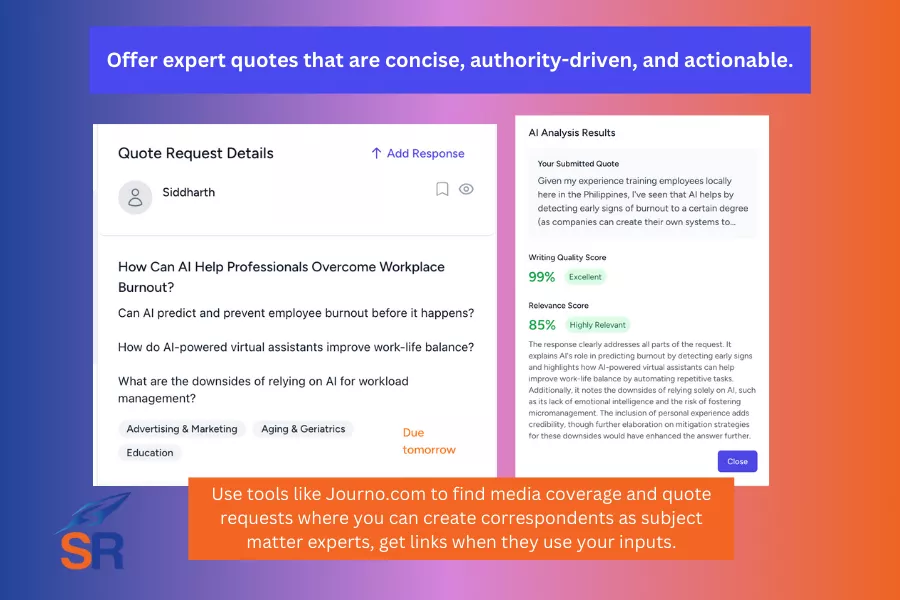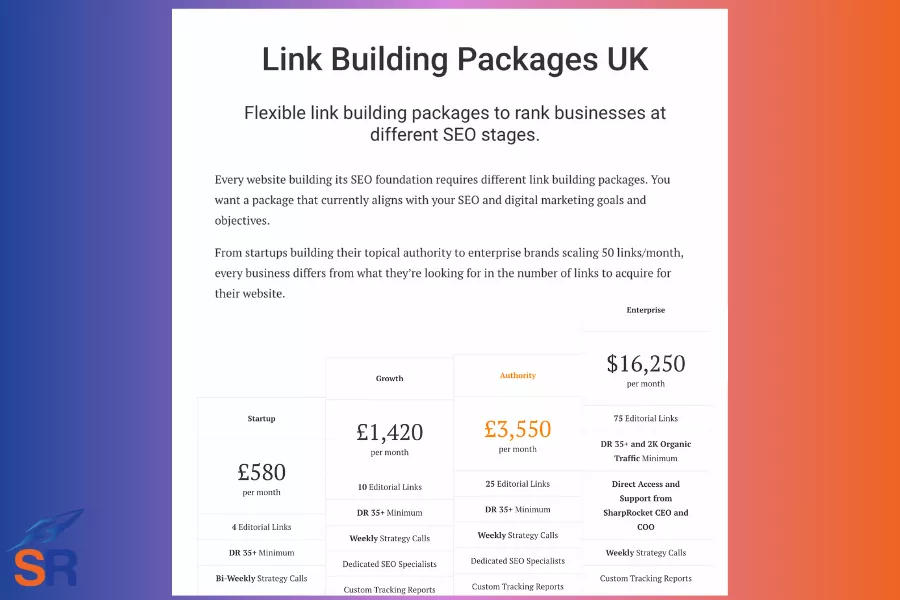Take it from someone who’s been building backlinks since 2013.
Getting backlinks today is more about leverage: scaling link building campaigns through the right teams, repeatable processes, and strategies aligned with your business objectives and the realities of your industry or client’s space.
This guide isn’t a rehash. It’s a deeper look at how to get backlinks today – what’s really important, and what’s getting backlinks in 2026 that nobody’s talking about yet.
If you’re tired of the “same-old” link building tactics and looking for real-world methods that earn links and scale, keep reading:
Contents
ToggleTarget Pages That Drive Revenue
One of the common mistakes SEO professionals make is diving into the actual execution of link building campaign without having the right strategy.
And when I say strategy, it’s not solely about the type of links you want to target and the methods you use (content seeding, product-led link building, listicle outreach, etc.); it’s also about choosing the right pages to build backlinks to.
Too often, link builders focus on blog posts or generic guides, as they are easier to pitch, but these don’t always align with what actually drives sales or leads.
One high-impact link building skill is learning how to align link building efforts to business objectives, so you can push rankings where it matters most.
Here are a couple of ways to pinpoint what pages to build links to:
Ask the client what matters most.
Start by asking the most direct question: which pages drive your online business? If they don’t provide the answer, you simply get access to their Google Analytics and Search Console.
Get clarity on
- What offers or services generate the most revenue?
- Are there specific categories or seasonal products to push?
- What pages are being prioritized by internal stakeholders – i.e. top management?
The answers you get will tell you where your link building needs to support business goals, so you’re not just building links to pages for traffic’s sake.
Use Ahrefs to find pages that need a push.
One of the simplest yet smartest ways to prioritize is to find pages that are already ranking in positions 6-20 for high-intent keywords. These are the pages closest to winning, and they often just need a handful of quality backlinks to break through.
Go to Ahrefs → Site Explorer → Organic Keywords. Filter for positions 6 to 20. Look for keywords with clear buyer intent (e.g., “buy”, “services”, “top X”, “best [product]”).
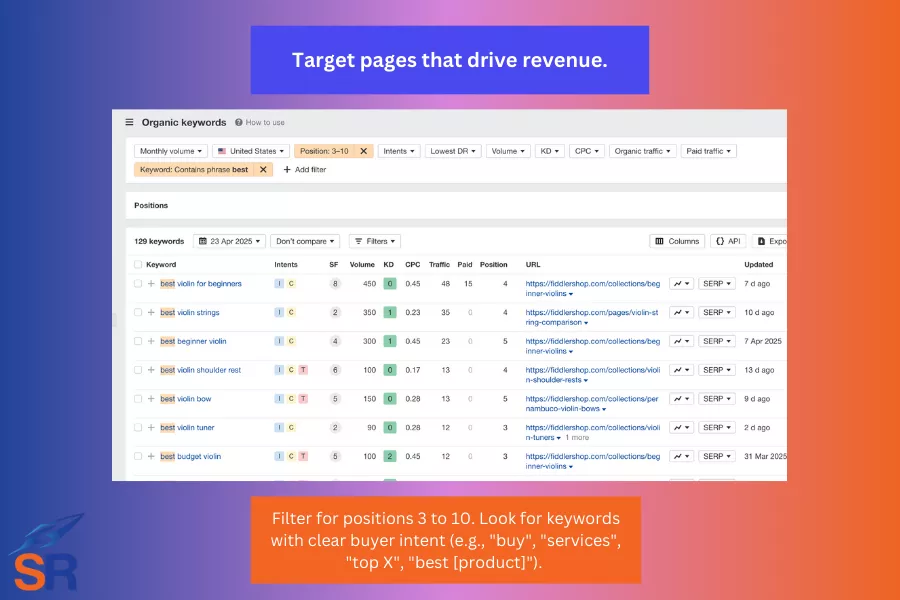
If you see that top competitors have 25 to 30 referring domains, and your page only has 5 to 10, you can close the gap with focused link building.
Look at conversion-driven pages.
See which pages consistently generate leads, sign-ups, or purchases, and if there are any high-converting pages stuck beyond page 1.
The idea is to build a few targeted backlinks to a service or product category page that drives actual revenue. Better building links to blog posts (of course, there are exceptions, but prioritize commercial pages in that matter).
Benchmark against competitors’ top-linked pages.
Reverse engineering your competitors by assessing how they attack their link building campaigns.
You can use link intelligence tools like Ahrefs to see which pages they build more links to (i.e., tools, data posts, etc.). This would give you insights and help you decide whether you need to:
- Build direct backlinks to your own target page
- Create a supporting asset to pass link equity through internal links
- Build domain authority first to compete against their top-ranking pages by creating more backlinks to your homepage or top-level content.
If you’re working with a site under DR30, start with homepage or top-level page links to build overall authority so that you can rank for more competitive keywords down the line.
However, for more established domains, you need to focus on revenue-driving pages, such as product category pages, high-intent service pages, or core solution hubs.
Audit Content Library to Find Link-Worthy Pages
Replicating what works already on your site in terms of earning links is the best way to get more quick wins (double down on what works).
The advantage is that you already have resources in place, such as your internal team, subject matter experts, and knowledge base that helped produce those initial assets. Instead of starting from scratch, you can double down on what’s proven to work and get more links with less friction.
You can also strengthen relationships with publishers who’ve linked to you in the past. By offering updated or future-related content (that you will then publish), you create opportunities for recurring links (not just to the original asset, but to other linkable pages within your site that also deserve visibility).
In our link building agency, we first identify which content assets from the client’s site can be effectively used for the link acquisition campaign, typically for content-led link building, product-led outreach, and link reclamation.
Start by reviewing all indexed pages and use tools like Ahrefs or SEMRush to extract performance data. Then, assess:
- Which URLs already have referring domains?
- Which content types earned links before (e.g., guides, templates, stat roundups)?
- Are any of these pages still relevant, or can they be refreshed and relaunched?
This creates a clear map of what content to push again for backlinks.
Here’s how to tie scalable link building strategies to the existing assets of your site:
- Content-led link building: Use evergreen blog posts, data roundups, industry guides, templates, or tools to create resource pages for outreach and contextual placements.
- Product-led outreach: Repurpose product pages, feature updates, or comparison assets to secure links from reviewers, bloggers, or roundup articles in your niche.
- Link reclamation: Identify pages with outdated URLs, past press mentions, or unlinked brand citations, and recover lost opportunities through targeted outreach and cleanup.
Auditing the content library and replicating what works is strategically sound, as you link the right asset to the right link building tactic, creating a stronger semantic relationship between the content type and its intended backlink.
» Not all backlinks are created equal. Learn the different types of backlinks and which ones actually move your rankings.
Systematize Link Building Strategies You Use Often
Random tactics don’t sustain results; repeatable systems do. That’s why one of the most valuable steps to scale link building is to build internal processes around the link building strategies you rely on most.
At SharpRocket, we’ve built robust, battle-tested processes for product-led outreach, content-led link building, and brand link reclamation.
We’ve created process maps that guide how our team operates on a daily basis. And by having the team fully own the tactical execution, it frees us (executives and the strategy team) to focus on the more strategic elements of link building, such as competitive analysis, campaign ideation, and client-specific customizations.
In terms of systematizing strategies, automation can dramatically speed up the tactical side of the process, especially in prospecting, data gathering, and link building outreach.
Here’s how we streamline our workflow:
Ahrefs for Prospecting and Research
We use Ahrefs’ Site Explorer to analyze competitor backlinks and identify high-authority referring domains worth pursuing. Another Ahrefs feature, its Content Explorer helps us find topically relevant articles and linkable pages that align with our assets.
Hunter.io for Contact Discovery
Using Hunter.io (with its Chrome extension), we collect and validate email addresses directly in our prospecting spreadsheet, allowing the team to skip manual email digging.
Gmass or Smartlead for Outreach Automation
These tools enable us to send bulk, personalized outreach emails, schedule follow-ups, and monitor open and reply rates, all while managing campaigns within Gmail or a dedicated outreach platform like SmartLead.
Internal Prospecting Workflow
We manage everything using Google Spreadsheets, equipped with a duplicate checker to ensure no overlapping outreach. We also use monthly master tabs for historical tracking and role-based assignments based on each team member’s niche or outreach strength.
Having a robust system like this makes it easy for us to assign link prospects, avoid collisions, and delegate tasks clearly, all while keeping the campaign agile and accountable.
» Tired of basic link tactics? Discover advanced link building strategies that focus on quality, context, and long-term SEO results.
Use Co-Authoring to Get Strategic Content Placements
Co-authoring content is a strategic way to earn high-authority backlinks while leveraging another person’s distribution reach. It creates a mutually beneficial exchange: you produce a content asset worth sharing, and your co-author uses their platform, relationships, or publication access to distribute it.
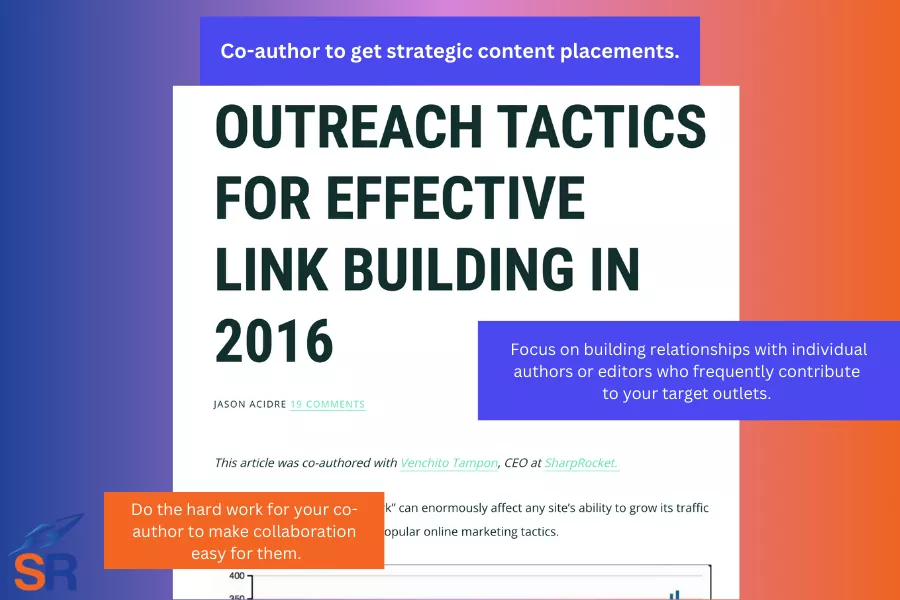
The best way to initiate this is to produce high-utility, original content on your site first, which will serve as solid proof of your expertise’s caliber, before engaging in outreach efforts to ask publishers to co-author with you.
The key is positioning the collaboration as a value-first exchange.
Here are a couple of ways to succeed with this approach:
Offer a Complete Draft or Framework.
Do the hard work for your co-author to make collaboration easy for them. Reach out with a nearly finished piece or a clear outline that aligns with their target audience.
Leverage Interview-based Contributions.
Send targeted authors a few insightful questions (not a full list of questions most SEO bloggers did in the past for long round-up articles).
Then, incorporate specific responses to relevant sections in the content. This makes the content more comprehensive and collaborative, giving co-authors a reason to co-promote or publish.
Co-own Distribution
Structure the deal so that they receive distribution through their network (e.g., social media followings, newsletters, client blogs, partner newsrooms), and you retain authorship or co-authorship credit, along with the backlink.
Target Authors, Not Just Publications
Focus on building relationships with individual authors or editors who frequently contribute to your target outlets. It is much easier to do co-authorship than a cold editorial pitch to the publication itself.
» Want to earn links by building your personal brand? Learn how to use authorship to improve link building and grow trust with publishers.
Analyze How Writers Actually Link To Sources
If you want to earn backlinks that last (either from creating linkable assets that passively earn links or through manual outreach), you need to understand how real writers reference content.

Spend time reviewing how top-tier publications and trusted blogs link to external sources. Pay attention to:
- Where the links appear within the article
- Preference of linking (reason for linking – e.g. how I chose the brands for this list).
- What kind of content do they link to (guides, original data, statistics, thought leadership)
- How the link is framed (look at the sentence, not just the anchor)
- What type of anchor text is used (descriptive, partial match, branded)
Writers often use descriptive anchor texts, not just exact match keywords, because they read more naturally and fit the editorial tone. For instance, instead of simply using “link building agency,” you’ll see publishers using descriptive anchor texts, such as “this case study by a leading outreach firm” or a “comprehensive breakdown of scalable link tactics.”
Understanding how editorial links work can help you craft content to become more linkable, as it aligns with real-world citation patterns.
Think and write as if you’re writing for top-tier publications. Match the content to how publishers could cite your work.
You can also use it to inspire your outreach campaigns with better angles, as your outreach suggestions mirror how writers structure references.
» Want backlinks from high-authority sites? Learn how to get DA 90+ backlinks with practical, white-hat strategies that actually work.
Build Strategic Alliances.
One of the sustainable methods to get hard-to-replicate links is by building genuine relationships with like-minded entities (people, brands, or organizations that share your values, audience, or goals).
The central premise is to form strategic content alliances with emerging voices and influential players in your space.
Look for people or brands with these attributes:
- Share similar goals or serve a common mission (e.g., ethical brands, open-source communities, educators).
- Target the same audience, but aren’t direct competitors.
- Hungry for growth, visibility, collaborations, and amplification, as they are still emerging influencers in your industry.
- Publishing regularly and investing in their website or content marketing.
Relationships take a long way in accumulating multiple link opportunities, often without the need for formal outreach.
Here are a few examples you can gain from relationship-based link acquisition:
- Content syndication: One party amplifies others’ content, and other publishers share yours, including a contextual backlink in their article.
- Cross-promotion: Mutual link exchange, where you link to their relevant article as a reference, and they reciprocate in future content.
- Co-created content (mentioned earlier): Roundups, webinars, or shared research pieces often include backlinks to both parties.
- Earned mentions: As they reference case studies or success stories, you’re more likely to be cited naturally.
By doing what’s unscalable (building relationships), you scale link building as you increase your trustworthiness and respect in the industry. This passively attracts links from other like-minded publishers, leading to better semantic proximity and more editorial trust for your site.
» Struggling to build links in a small niche? Here’s how to build backlinks in very small niches without relying on big content or outreach lists.
Use AI to Deepen Research, Then Humanize for Link-Worthy Content
If you rely on what other SEO publishers teach about AI-written content to pass AI detector tools and could rank well in Google’s SERPs without human editing, think again.
Instead of using it to generate entire articles that may lead to generic, lifeless content, you can use AI to go deeper into research and insight discovery.
By augmenting your content creation strategy without fully automating it, you create a significant edge in your content-led link-building campaigns.
As a content publisher for a decade now, I’ve seen how AI today gives you instant access to diverse perspectives, alternative phrasings, and emerging subtopics, all of which will help you build deeper, more comprehensive content that resonates well with writers, editors, and readers.
Marie Haynes, in her recent article, explains how she uses AI as a research assistant, not as a ghostwriter. Her best content writing tip is to input complex industry topics and let AI surface fresh questions, find patterns, and offer varied perspectives that might have been missed.
The output from here are refined topics that you can use to make the final content richer, more nuanced, and closer to the intent behind user searches.
Kevin Indig makes the AI-assistant writing process even more actionable. He breaks the editing process into four rounds that turn AI output into link-worthy editorial content.
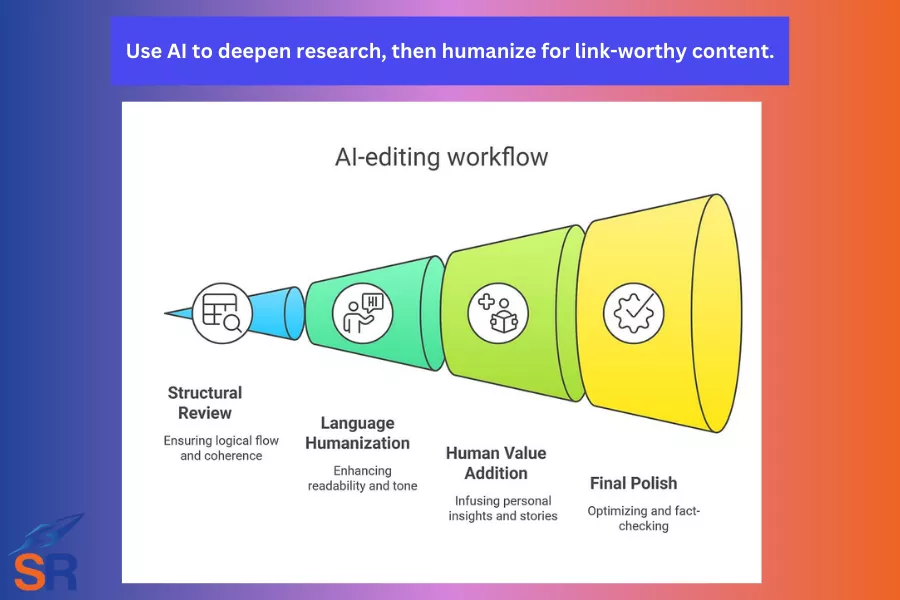
The elements that matter:
- Structure: Rearrange sections to create a logical flow and clarity, and remove redundancy to ensure the content directly addresses search intent.
- Language: Eliminate robotic phrasing. Vary sentence lengths. Use plain, human language.
- Humanization: Add personal opinions, stories, metaphors, cultural context, and emotional cues – things AI can’t replicate.
- Polish: Check for SEO alignment (headings, internal links, CTAs), fact accuracy, and final readability.
Helpful content assisted with AI’s deeper research helps you create a connection with your target audience, making it even more attractive for link building, as the content:
- Shows original thinking
- Demonstrates deep and real expertise
- Provides depth and clarity (easy to read, easy to skim)
- Feels authentically human (in other words, engaging)
The best content today comes from creators who know how to steer the algorithmic output with human judgment, insight, and originality, resulting in content assets that get cited by other publishers in their space.
Exclusive Directories
Creating your exclusive directories that feature other businesses in your industry can be a lever to develop relationships with other publishers. And it’s also a way to increase trust and visibility for your site, being the host of the directory.
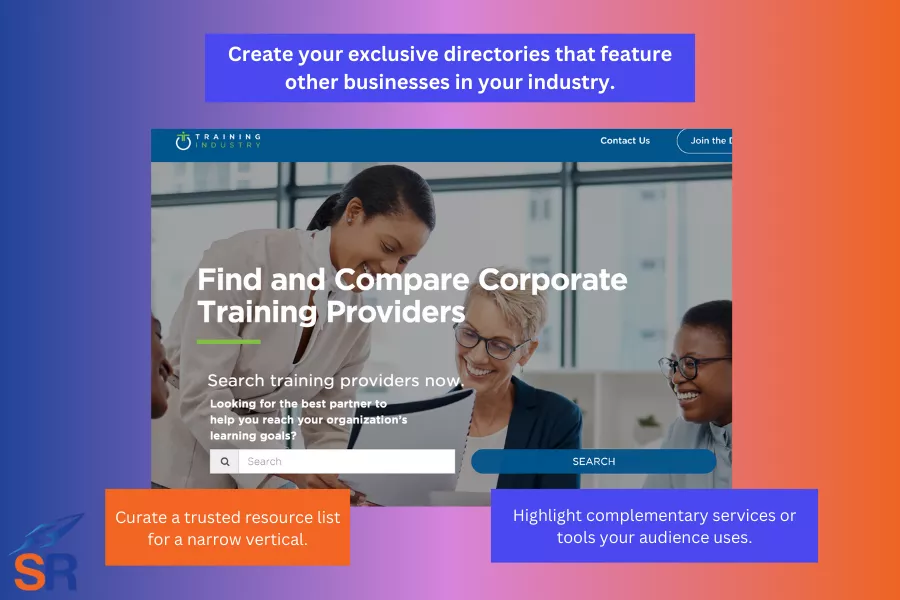
Choose a segmented audience you want to include in your directories. Examples could be:
- Vendors, service providers, or platforms that your audience actively seeks
- Indirect competitors: companies that serve your target market, but offer solutions you don’t
- Influencers, creators, or niche-specific brands are gaining traction in your vertical
- Thought leaders and educators, especially those who are underrated and don’t have an active social following, have significantly contributed to the community through their expertise.
The real power of exclusive directories lies in their shareability and ego appeal. When people are mentioned in a top list or featured as a trusted vendor, they are often proud of the recognition and naturally want to share or link back to that page.
You’ve given them third-party validation, which motivates them to share it on their blog, social media, or press page and add a backlink to their “As Featured In” or “Awards’ section.
Position your directory to target a particular segment of vendors. Instead of competing with G2 or Capterra, you can:
- Curate a trusted resource list for a narrow vertical
- Highlight complementary services or tools your audience uses
- Feature local or niche-based providers
For instance, Cyrus Shepard recently launched his agency directory featuring SEO and digital marketing agencies he trusts to deliver results.

What makes this asset powerful isn’t just the curated list, it’s the implicit endorsement. Being included in a list curated by a trusted industry voice like Cyrus carries authority, credibility, and immediate shareability.
» Need quick wins for your SEO campaign? Try these easy link building strategies that are simple to execute but still effective.
Build a Learning Center
Creating a learning center is one of the most effective long-term, linkable asset investments you can make, benefiting far beyond just SEO. By publishing a structured hub of educational and evergreen content, you establish your website as a go-to source of information in your niche, where visitors would go directly to your learning center to digest more of your content.
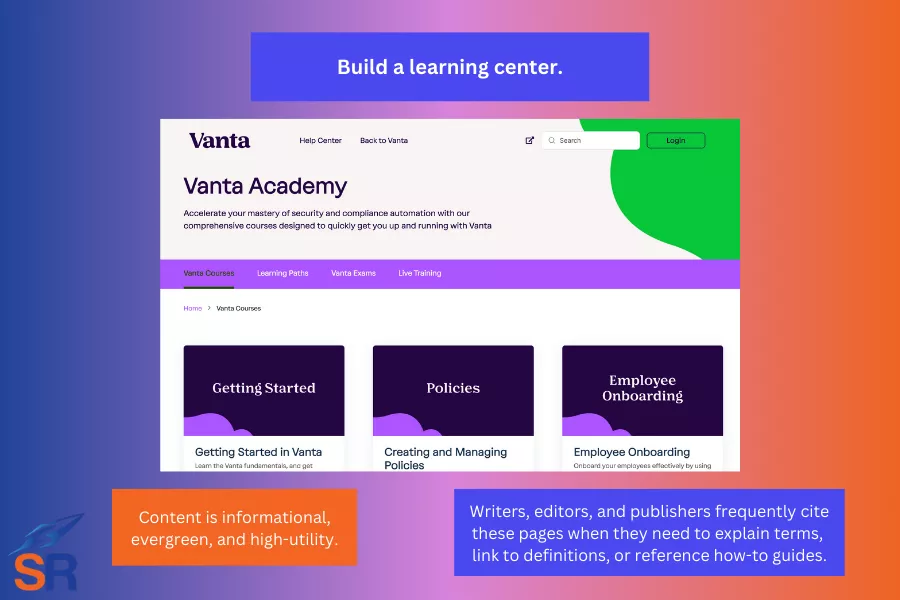
In many ways, your learning center becomes a solid linkable asset that generates continuous backlinks, given that:
- The content is informational, evergreen, and high-utility
- It can rank for question-based informational queries, such as “What is [industry term]”, “How to [solve problem]”, or “Why use [solution]”.
- Writers, editors, and publishers frequently cite these pages when they need to explain terms, link to definitions, or reference how-to guides.
By investing resources in a learning center, you compound your benefits into more passive link earning, from which you can maximize and reinforce link equity across your landing pages through internal linking.
Another way learning centers can help your website beyond just SEO is that they reduce the support load by acting as a self-service help desk (think FAQs, tutorials, and troubleshooting guides). This way, it supports your sales team by educating and attracting the right types of customers.
» Running complex outreach campaigns? Learn how to manage advanced link building campaigns with better systems, tools, and team workflows.
Align Link Building Efforts to Business Objectives
The best link building campaigns are the ones that support the broader business goals behind those rankings. Your link building efforts should be directly tied to what matters most to the business.
In the recent 2025 Link Building Survey by Citation Labs and BuzzStream, more SEOs are shifting their focus from raw link volume to strategic alignment (building links to pages that serve a specific purpose in the customer journey) – a link building approach I’ve been an advocate for years.
When your link building becomes a business growth lever, it supports your broader objectives, such as:
- Your reporting improves (you can measure business impact, not just link count).
- Your content prioritization becomes clearer (what to promote, what pages to get most inbound links)
- Your internal buy-in strengthens, especially when discussing link building campaigns with sales, product, brand teams, CMOs, and other key internal stakeholders.
- You retain agency/client relationships as you’re driving more meaningful results.
Have an end in mind when executing your link building campaigns, incorporating important pages for the business, which include:
- Revenue-generating product and category pages
- Resource hubs that boost topical authority
- Long-form content that powers discovery and brand awareness.
I’ve covered this on how tools like Link Launch can make your link building investment more justifiable. Check out this guide on our best link building tools for SEO.
Remember that the best links are the ones that move both rankings and revenue.
One Mention to Many
Showing up in many product listicles can help you earn compounding, passive backlinks from other product listicles within your niche, often without doing outreach.
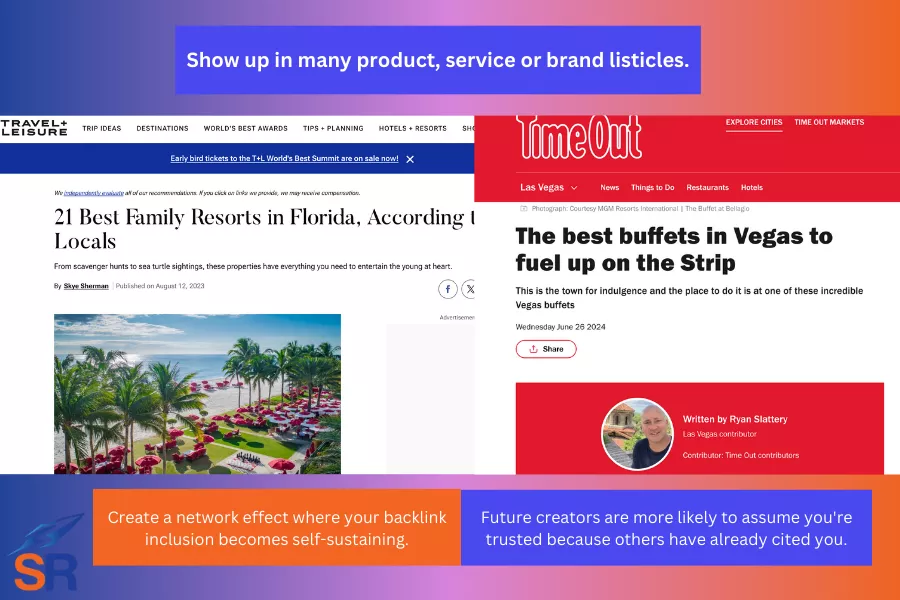
Aim to have your brand included in many product and content listicles by manually pushing direct link requests. Given that publishers who build these lists often use existing listicles as their search base, if your brand or content consistently appears in trusted lists (your roundup, others’ listicles, directories), future creators are more likely to assume you’re trusted because others have already cited you.
It puts your brand, product, or content in front of more eyes, creating a network effect where your backlink inclusion becomes self-sustaining. That’s where the real backlink compounding happens.
Scalable Reverse Engineering.
Reverse engineering competitors and even your own brand is an old link-building tactic, but few implement it systematically at scale and take full advantage of it.
By tracking brand mentions using Ahrefs’ Alerts, Google Alerts, or Mentions, you strike while the page is fresh.
Pitches sent just a few days after a page gets published (or indexed) have a much higher success rate than cold pitches sent weeks or months later (similar to how reactive digital PR campaigns work – you react immediately on breaking stories to take advantage of the hype/virality effect).
Given that the content is still top of mind for the author or editor, it is also easier to edit (especially before it’s widely shared) and actively monitored (since writers often review early feedback on the content) – this window gives you a key advantage.
Instead of pitching something out of context, you’re offering a small, relevant addition to a just-published piece. So, whether it’s a quick request to add a link to your own brand (link reclamation) or a subtle suggestion of an alternative to a competitor, editors are far more receptive when the content is fresh.
Another advantage of scaling reverse engineering is that you can turn mentions into relationships.
When someone mentions your brand (linked or not), it’s an opportunity to build long-term relationships. By appreciating their kindness, you position yourself as helpful and more human, and when scaled, it could lead to more contextual backlinks and future content collaborations.
» Looking for links that actually improve rankings? Explore our link building services designed to achieve your organic growth.
Written By
Venchito Tampon
CEO and Co-Founder at SharpRocket, a link building agency. With a decade of experience, Venchito has a proven track record of leading hundreds of successful SEO (link builidng) campaigns across competitive industries like finance, B2B, legal, and SaaS. His expert advice as a link building expert has been featured in renowned publications such as Semrush, Ahrefs, Huffington Post and Forbes. He is also an international SEO spoken and has delivered talks in SEO Zraz, Asia Pacific Affiliate Summit in Singapore, and Search Marketing Summit in Sydney, Australia. Check out his other business - Hills & Valleys Cafe.
Reviewed By

Sef Gojo Cruz
COO at SharpRocket, overseeing end-to-end operations, from crafting link building strategies to leading high-performing teams. Previously led SEO initiatives at Workhouse, a digital agency in Australia, and Keymedia, a real estate media company based in New Zealand.
How our LINK BUILDING AGENCY in UK builds 250 links/mo consistently using Predictable Link Building Methodology™…
- Using a SIMPLE and PROVEN system
- Using a SCALABLE strategy
- No private blog networks
- No creepy outreach emails
